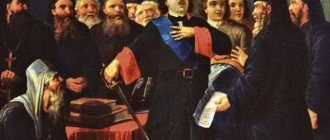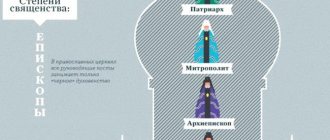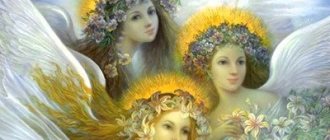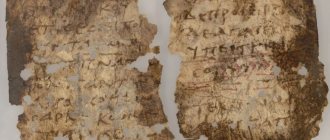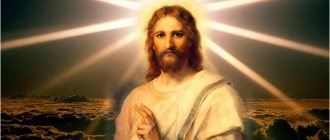1. Brief history of the Russian Orthodox Church
. 2. The structure of the Russian Orthodox Church. 3. His Holiness Patriarch of Moscow and All Rus'. 4. Charter of the Russian Orthodox Church. 5. Fundamentals of the Social Concept of the Russian Orthodox Church. 6. Fundamentals of the teaching of the Russian Orthodox Church on dignity, freedom and human rights. 7. Official website of the Russian Orthodox Church. 8. Official website of the St. Petersburg Metropolis. 9. Official website of the Vyborg diocese.
A BRIEF HISTORY OF THE RUSSIAN ORTHODOX CHURCH.
The Russian Orthodox Church has a history of more than a thousand years. According to legend, the holy Apostle Andrew the First-Called, preaching the Gospel, stopped at the Kyiv Mountains and blessed the future city of Kyiv. The spread of Christianity in Rus' was facilitated by its proximity to a powerful Christian power - the Byzantine Empire. The south of Rus' was sanctified by the activities of the holy Equal-to-the-Apostles brothers Cyril and Methodius, apostles and educators of the Slavs. In 954, Princess Olga of Kiev was baptized. All this prepared the greatest events in the history of the Russian people - the baptism of Prince Vladimir and the Baptism of Rus' in 988. In the pre-Mongol period of its history, the Russian Church was one of the metropolises of the Patriarchate of Constantinople. The metropolitan who headed the Church was appointed by the Greek Patriarch of Constantinople, but in 1051 the Russian Metropolitan Hilarion, the most educated man of his time and a remarkable church writer, was first installed on the high priestly throne. Since the 10th century, majestic temples have been built. Since the 11th century, monasteries began to develop in Rus'. In 1051, the Monk Anthony of Pechersk brought the traditions of Athonite monasticism to Rus', founding the famous Kiev-Pechersk Monastery, which became the center of the religious life of Ancient Rus'. The role of monasteries in Rus' was enormous. And their main service to the Russian people - not to mention their purely spiritual role - is that they were the largest centers of education. In the monasteries, in particular, chronicles were kept that brought to this day information about all significant events in the history of the Russian people. Icon painting and the art of book writing flourished in the monasteries, and translations of theological, historical and literary works into Russian were carried out. The extensive charitable activities of monastic monasteries contributed to the cultivation of the spirit of mercy and compassion among the people. In the 12th century, during the period of feudal fragmentation, the Russian Church remained the only bearer of the idea of the unity of the Russian people, counteracting the centrifugal aspirations and civil strife of the princes. The Tatar-Mongol invasion - the greatest disaster that befell Rus' in the 13th century - did not break the Russian Church. She remained as a real force and was a comforter to the people in this difficult trial. Spiritually, materially and morally, she contributed to the restoration of the political unity of Rus' - the key to future victory over the enslavers. The unification of disparate Russian principalities around Moscow began in the 14th century. And the Russian Church continued to play an important role in the revival of a united Rus'. Outstanding Russian saints were the spiritual leaders and assistants of the Moscow princes. Saint Metropolitan Alexy (1354-1378) raised the holy noble prince Demetrius Donskoy. He, like later Saint Metropolitan Jonah (1448-1471), by the power of his authority helped the Moscow prince in ending feudal unrest and preserving state unity. The great ascetic of the Russian Church, St. Sergius of Radonezh, blessed Demetrius Donskoy for the greatest feat of arms - the Battle of Kulikovo, which served as the beginning of the liberation of Rus' from the Mongol yoke. Monasteries greatly contributed to the preservation of the national identity and culture of the Russian people during the difficult years of the Tatar-Mongol yoke and Western influences. In the 13th century, the beginning of the Pochaev Lavra was laid. This monastery and its abbot, Reverend Job, did a lot to establish Orthodoxy in Western Russian lands. In total, from the 14th to the half of the 15th century, up to 180 new monastic monasteries were founded in Rus'. The largest event in the history of ancient Russian monasticism was the founding of the Trinity-Sergius Monastery by St. Sergius of Radonezh (around 1334). Here, in this later famous monastery, the wondrous talent of the icon painter St. Andrei Rublev blossomed. Freed from the invaders, the Russian state gained strength, and with it the strength of the Russian Orthodox Church grew. In 1448, shortly before the fall of the Byzantine Empire, the Russian Church became independent of the Patriarchate of Constantinople. Metropolitan Jonah, installed by the Council of Russian Bishops in 1448, received the title of Metropolitan of Moscow and All Rus'. Subsequently, the growing power of the Russian state contributed to the growth of the authority of the Autocephalous Russian Church. In 1589, Moscow Metropolitan Job became the first Russian Patriarch. The Eastern Patriarchs recognized the Russian Patriarch as fifth in honor. The 17th century started out hard for Russia. Polish-Swedish invaders invaded Russian Land from the west. During this time of unrest, the Russian Church, as before, honorably fulfilled its patriotic duty to the people. The ardent patriot Patriarch Ermogen (1606-1612), tortured by the interventionists, was the spiritual leader of the militia of Minin and Pozharsky. The heroic defense of the Trinity-Sergius Lavra from the Swedes and Poles in 1608-1610 is forever inscribed in the chronicle of the history of the Russian state and the Russian Church. In the period following the expulsion of the interventionists from Russia, the Russian Church dealt with one of its very important internal problems - the correction of liturgical books and rituals. Much of the credit for this belonged to Patriarch Nikon. The beginning of the 18th century was marked for Russia by the radical reforms of Peter I. The reform also affected the Russian Church: after the death of Patriarch Adrian in 1700, Peter I delayed the election of a new Primate of the Church, and in 1721 established a collegial higher church administration represented by the Holy Governing Synod, which remained the highest church body for almost two hundred years. During the Synodal period of its history (1721-1917), the Russian Church paid special attention to the development of spiritual education and missionary work on the outskirts of the country. The restoration of old and the construction of new temples was carried out. The beginning of the 19th century was marked by the activities of remarkable theologians. Russian church scientists did a lot for the development of such sciences as history, linguistics, and oriental studies. The 19th century gave great examples of Russian holiness: the outstanding hierarchs, Metropolitans of Moscow Philaret and Innocent, St. Seraphim of Sarov, the elders of the Optina and Glinsk hermitages. At the beginning of the twentieth century, preparations began for the convening of the All-Russian Church Council. The Council was convened only after the February Revolution - in 1917. His greatest act was the restoration of the Patriarchal administration of the Russian Church. Metropolitan Tikhon of Moscow was elected at this Council as Patriarch of Moscow and All Rus' (1917-1925). Saint Tikhon made every effort to calm the destructive passions fanned by the revolution. The Message of the Holy Council dated November 11, 1917 said: “Instead of the new social structure promised by the false teachers, there is a bloody feud among the builders; instead of peace and brotherhood of peoples, there is confusion of languages and bitter hatred of brothers. People who have forgotten God rush at each other like hungry wolves... Leave the crazy and wicked dream of false teachers who call for the implementation of world brotherhood through world civil strife! Return to the path of Christ!' For the Bolsheviks, who came to power in 1917, the Russian Orthodox Church was a priori an ideological enemy. That is why many bishops, thousands of priests, monks, nuns and laity were subjected to repression, including execution and murders that were shocking in their cruelty. When in 1921-22 the Soviet government demanded the release of valuable sacred objects, things came to a fatal conflict between the Church and the new government, which decided to use the situation for the complete and final destruction of the Church. By the beginning of World War II, the church structure throughout the country was almost completely eliminated. There were only a few bishops left free who could perform their duties. In the entire Soviet Union, only a few hundred churches were open for worship. Most of the clergy were in camps, where many were killed or disappeared. The catastrophic course of hostilities for the country at the beginning of World War II forced Stalin to mobilize all national reserves for defense, including the Russian Orthodox Church as a popular moral force. Temples opened for worship. The clergy, including bishops, were released from the camps. The Russian Church did not limit itself only to spiritual support for the cause of defending the Fatherland in danger - it also provided material assistance, including uniforms for the army, financing the tank column named after Dmitry Donskoy and the squadron named after Alexander Nevsky. The culmination of this process, which can be characterized as the rapprochement of the state and the Church in “patriotic unity,” was Stalin’s reception on September 4, 1943 of the Patriarchal Locum Tenens Metropolitan Sergius (Stragorodsky) and Metropolitans Alexy (Simansky) and Nikolai (Yarushevich). From this historical moment, a “thaw” began in relations between the Church and the state, but the Church was constantly under state control, and any attempts to expand its activities outside the walls of the temple met with unyielding resistance, including administrative sanctions. The position of the Russian Orthodox Church was difficult during the period of the so-called “Khrushchev Thaw”, when thousands of churches throughout the Soviet Union were closed for the sake of ideological principles. The celebration of the Millennium of the Baptism of Rus' in 1988 marked the decline of the state-atheist system, gave new impetus to church-state relations, forced those in power to begin a dialogue with the Church and build relationships with it on the principles of recognition of its enormous historical role in the fate of the Fatherland and its contribution to the formation of moral foundations of the nation. The true return of the people to the Father's house began - people were drawn to Christ and His Holy Church. Archpastors, pastors, and laity began to work zealously to recreate full-blooded church life. At the same time, the absolute majority of clergy and believers showed extraordinary wisdom, endurance, steadfastness in faith, devotion to Holy Orthodoxy, despite neither the difficulties with which the revival was associated, nor the attempts of external forces to split the Church, undermine its unity, deprive it of internal freedom, and subjugate it. worldly interests. Even the collapse of the Soviet Union in 1991, accompanied by a widespread increase in national egoism, could not destroy the multi-ethnic nature of the Moscow Patriarchate. The desire to enclose the Russian Orthodox Church within the framework of the Russian Federation and the national diasporas associated with it has so far proven futile. However, the consequences of the persecution turned out to be very, very serious. It was necessary not only to restore thousands of churches and hundreds of monasteries from ruins, but also to revive the traditions of educational, educational, charitable, missionary, church and public service. Metropolitan Alexy of Leningrad and Novgorod, who was elected by the Local Council of the Russian Orthodox Church to the First Hierarchal See, widowed after the death of His Holiness Patriarch Pimen, was destined to lead the church revival in these difficult conditions. On June 10, 1990, the enthronement of His Holiness Patriarch of Moscow and All Rus' Alexy II took place. Under his First Hierarchal omophorion, the Russian Orthodox Church undertook the most difficult efforts to recreate what was lost during the years of persecution. Peculiar milestones on this difficult path were the Bishops' Councils of the Russian Orthodox Church, at which current problems of church revival were freely discussed and decisions were made on canonical, disciplinary and doctrinal issues. The Bishops' Council of the Russian Orthodox Church on March 31 - April 5, 1992, held in Moscow, made a number of important decisions regarding church life in Ukraine and the canonical position of the Ukrainian Orthodox Church. At the same Council, the beginning was laid for the glorification of the holy new martyrs and confessors of Russia, who suffered for Christ and His Church during the years of persecution. In addition, the Council adopted an appeal in which it outlined the position of the Russian Orthodox Church on issues that worried society in the countries in which its flock lives. The Council of Bishops of the Russian Orthodox Church on June 11, 1992 was convened on an extraordinary basis to consider the case on charges of Metropolitan Philaret of Kyiv in anti-church activities that contributed to the split of the Ukrainian Orthodox Church. In a special “Judicial Act,” the Council decided to depose Metropolitan of Kyiv Philaret (Denisenko) for committing grave moral and canonical crimes and causing a schism in the Church. The Bishops' Council of the Russian Orthodox Church on November 29 - December 2, 1994, in addition to a number of decisions concerning internal church life, adopted a special definition 'On the relationship of the Church with the state and secular society in the canonical territory of the Moscow Patriarchate at the present time', in which it confirmed the 'non-preference' for the Church of any political system, political doctrine, and so on, the inadmissibility of the Church's support of political parties, and also prohibited clergy from nominating themselves for elections to local or federal authorities. The Council also decided to begin developing “a comprehensive concept reflecting the church-wide view on issues of church-state relations and the problems of modern society as a whole.” The Council especially noted the need to revive the missionary service of the Church and decided to develop a concept for the revival of the missionary activity of the Russian Orthodox Church. In pursuance of the decisions of the Council of Bishops in 1994, the Holy Synod in December 1995 decided to form the Missionary Department of the Moscow Patriarchate. The Council of Bishops of the Russian Orthodox Church on February 18 - 23, 1997 continued work on the church-wide glorification of the new martyrs and confessors of Russia. In addition, the themes discussed at the Council of Bishops in 1994, which outlined the most important tasks and trends in church life, were developed in council reports and discussions. In particular, the Council confirmed the inviolability of the church position on the issue of the inadmissibility of participation of the Church and its ministers in political struggle. In addition, the prospects for the participation of the Russian Orthodox Church in international Christian organizations, problems of missionary and social service of the Church, threats to the proselytizing activities of heterodox and heterodox religious associations were discussed. The Anniversary Council of Bishops of the Russian Orthodox Church met on August 13-16, 2000 in the Hall of Church Councils of the recreated Cathedral of Christ the Savior. The meetings of the Council, which ended with the solemn consecration of the Temple, were included in the circle of celebrations dedicated to the great Jubilee - the 2000th anniversary of the Coming of our Lord and Savior Jesus Christ into the world. The Council became a unique phenomenon in the life of the Russian Orthodox Church in terms of the number and significance of the decisions it made. According to the report of Metropolitan Yuvenaly of Krutitsy and Kolomna, Chairman of the Synodal Commission for the Canonization of Saints, a decision was made to glorify for church-wide veneration in the ranks of saints the Council of New Martyrs and Confessors of Russia of the 20th century, known by name and hitherto unknown to the world, but known to God. The Council considered materials about 814 ascetics whose names are known, and about 46 ascetics whose names could not be established, but about whom it is reliably known that they suffered for the faith of Christ. The names of 230 previously glorified locally venerated saints were also included in the Council of New Martyrs and Confessors of Russia for church-wide veneration. Having considered the issue of canonization of the Royal Family, the members of the Council decided to glorify Emperor Nicholas II, Empress Alexandra and their children: Alexy, Olga, Tatiana, Maria and Anastasia as passion-bearers in the Council of New Martyrs and Confessors of Russia. The Council made a decision on the general church glorification of the ascetics of faith and piety of other times, whose feat of faith was different from that of the new martyrs and confessors. The members of the Council adopted the Basic Principles of the Russian Orthodox Church’s attitude towards heterodoxy, prepared by the Synodal Theological Commission under the leadership of Metropolitan Philaret of Minsk and Slutsk. This document became a guide for clergy and laity of the Russian Orthodox Church in their contacts with non-Orthodox people. Of particular importance is the adoption by the Council of the Fundamentals of the social concept of the Russian Orthodox Church. This document, prepared by the Synodal Working Group under the leadership of Metropolitan Kirill of Smolensk and Kaliningrad and the first document of its kind in the Orthodox world, sets out the basic provisions of the teaching of the Church on issues of church-state relations and on a number of modern socially significant problems. The document reflects the official position of the Moscow Patriarchate in the field of relations with the state and secular society. In addition, a new charter of the Russian Orthodox Church was adopted at the cathedral, prepared by the Synodal Commission for Amendments to the Charter on the Office of the Russian Orthodox Church under the leadership of Metropolitan of Smolensk and Kaliningrad Cyril. The church is currently guided by this charter. The cathedral adopted a message to the God -loving shepherds, honest inemics and all the faithful children of the Russian Orthodox Church, the definition of the Ukrainian Orthodox Church, the definition of the position of the Orthodox Church in Estonia and the definition of issues of the internal life and external activities of the Russian Orthodox Church.
Short stories from church life
Alexandria sheep
| Archpriest Sergiy Pravdolyubov |
In my now distant youth there were many interesting incidents in student and subdeaconal life.
I would like to remember some of them. His Holiness and Beatitude Pope and Patriarch of Alexandria Nicholas VI, Judge of the Universe, came to Moscow. This is not the whole title I mentioned. For some reason, the seminarians especially liked the “judge” in the title, but these two words have a very ancient origin.
The meeting in the Patriarchal Epiphany Cathedral was most solemn. To the second pair of subdeacons, Fr. Sergius Sokolov (the now deceased Bishop of Novosibirsk) and I were tasked with vesting the Ecumenical Patriarch in the middle of the church. Accordingly, the first subdeacon was responsible for the buttons, omophorion and panagia, that is, the front side of the Patriarch, and I was responsible for the “rear”. Before the service, I was instructed that the club in Alexandria is not worn over the shoulder, but is tied with a special loop, and everything else seems to be the same with us.
The choir sings, the entrance prayers are read, the Patriarch ascends to the pulpit, and vestments begin. Everything goes smoothly, there are no errors.
And at the very end, when all the complex buttons of the omophorion were already fastened, I looked and saw that the omophorion, somehow strangely, not in Russian, lay right on the Patriarch’s neck, and not vertically and solemnly raised, like all our bishops. I decided that this was my oversight, and quietly, carefully pulled him towards me and positioned him in the Russian manner. The Patriarch just as quietly pulled him back to his neck. My Ryazan intelligence was not enough to understand the full significance of the reverse movement of the omophorion of the Alexandrian saint. And I again returned the omophorion to its original place, pulling it in my direction. The Patriarch again, this time angrily and decisively, repeated the previous movement. And this time I did not heed all the danger of the formidable Judge of the Universe.
Seeing the approaching archpriest with a tray in his hands and three panagias, I thought that the chains should be placed under the omophorion, as is our custom, but it was in the way, lying on the neck. And when I pulled the omophorion of the Patriarch of Alexandria for the third time, he sharply turned sideways to me and, in Greek, with anger and irritation, energetically and angrily expressed to me all his indignation. I was frightened, asked for forgiveness, and only when I saw that Father Sergius Sokolov was placing the chains from the panagia on top of the omophorion, and that it rested firmly and unshakably on the saint’s neck, did I realize that this was ancient Alexandrian symbolism with the deepest meaning, it’s just that no one warned me.
The omophorion should lie on the neck, for it symbolizes the lost sheep, which the Good Shepherd - Christ - takes on his shoulders and carries to his home in order to heal it and return it healthy to the flock. Let us take it in the frame and bring it to the Father. Likewise, the Patriarch of Alexandria, following the example of the Savior, takes on his shoulders and presses the symbolic Alexandrian sheep to his saintly neck with chains from panagias. And I, a Ryazan “newcomer” to the Moscow shrines, committed blatant sacrilege: I pulled this very sheep from the shoulders of the Judge of the Universe, thereby publicly trying to deprive him of his patriarchal and hierarchal dignity in the midst of Russian soil! I hope that the Patriarch did not excommunicate me from the fullness of Alexandrian Orthodoxy, understood my slowness and simply scolded me severely.
Perhaps all this happened from my crafty exaltation, which I involuntarily experienced the day before, during the all-night vigil.
The translator accompanying the Patriarch of Alexandria, professor of Greek at the Moscow Theological Academy, master of theology and specialist in the Ancient Eastern Churches, Boris Aleksandrovich Nelyubov (by the way, the most humble and kindest man), called me during the sixth psalm and said:
“Father Sergius, please help me, I won’t go out in the middle of the church in my suit, and most likely the Patriarch will be asked to read the Gospel.” He simply will not understand what duty station he is in. We need to tell him in Greek: “Reading the Gospel from Mark.” And it is not necessary to say the whole phrase, it is enough to say the beginning: “Ek tu kata Marku...”, then he will say it himself.
I remembered the phrase and promised not to forget and to give me a hint.
We went out to “Praise”, sang everything that was required, the deacon said the prokeimenon, our Patriarch said: “Peace to all.” The very moment came when everything happened as Boris Alexandrovich had foreseen. And so, in complete silence and silence, after a short pause, I, a Ryazan newcomer, completely at ease, in an undertone, say as something self-evident:
- “Ek tu kata Marku...”
And the Ecumenical Patriarch, immediately getting his bearings, repeated the whole phrase after me and began to read the Gospel.
Patriarch Pimen literally pierced me with his gaze, as if saying: “Where does this come from? Can anything good come from Ryazan? All the student subdeacons silently gasped: “Fr. Sergius, it turns out he can easily speak Greek!” And I became famous in Pharaoh, and in all his chariots and cavalry, in the tristats and other creatures... And no one doubted or thought that there was a simple hint here. And Boris Alexandrovich, when we returned to the altar, understood everything, smiled and did not publicly destroy the idol that was erected in three seconds in silence in the middle of the Patriarchal Epiphany Cathedral.
Cat in the Cathedral
The usual all-night vigil was going on at the Epiphany Cathedral on Sunday. They sang “Praise” and His Holiness read the Gospel. We approached the anointing and went to the altar. At the very wall in the southern part of the altar, behind a plywood partition, there was a secluded place where one could sit unnoticed until the authorities were close, and the two priests went there, hoping to be in silence and contemplation. They walked in calmly and suddenly quickly jumped back out. What's happened?
Some stray cat, who managed to grow to adulthood and remain wild, wandered into the priest’s shelter during the day to rest, sat there, and then was afraid to go out when the service began. It was he who hissed with a threatening lynx spike at the cathedral archpriests. They got scared, then began to look at who was hissing so terribly there. The cat was large, brownish-red, and apparently ferocious.
Father Archimandrite Tryphon said:
- Call Father Sergius, he grew up in the village, let him try to drive him out of here.
But as a child, I was never distinguished by my love of catching cats and never had the desire to imitate Lermontov’s Mtsyri in his duel. But the archimandrite’s word must be fulfilled.
He found some thicker rag, came as close as possible - and, it should be noted, in his surplice, he didn’t even think of taking it off - he lunged and wanted to grab the animal by the back. The cat guessed my maneuver and at the same moment suddenly jumped forward at my feet. Only the tail was in my hands, and the cat began to violently free itself. Standing nearby were Father Archimandrite Tryphon, Father Archdeacon Stefan and Father Subdeacon, or maybe then already Hierodeacon Agathodorus, the current governor of the Donskoy Monastery.
I warned:
- Help! The cat is breaking out! He'll leave now!
No one reacted or came closer. They were afraid. Finally, the cat broke free and quickly and energetically began to cross the space on the right side of the altar, intending to jump out of the southern side door. The cat’s chosen route passed right under Fr.’s feet. Tryphon, and he suddenly made some completely unnatural curtsy, thinking that the cat, covered with the archimandrite’s robe, would lose direction, be afraid of the monastic darkness, and we would catch him again.
Not so. The cat was not at all embarrassed by either the darkness or His Reverence’s cassock and, slipping out, ran along the intended path at the same speed.
At this time, the litany for the third song of the canon began. And everything would have worked out well if not for the huge mirror that was built into the door of the vestment closet. It was so clean, so neatly wiped with someone’s caring cloth that the cat, seeing the reflection of the slightly open door in the mirror, rushed through this gap to run out of the altar.
There was a dull thud as the cat crashed its head into the mirror. He was literally thrown back a meter and a half. The cat realized that he could not escape from here through the side door, so to speak, and ran to the Royal Doors of the main altar. At this time the litany ended and Fr. Nikolai Vorobyov, the sacristan of the Patriarchal Cathedral, finished speaking with an exclamation for the third song of the canon. According to the charter, you are supposed to turn at the end of the exclamation and bow to His Holiness the Patriarch, who at that time was anointing the people. During the anointing, Patriarch Pimen did not look towards the Royal Doors. But at the priest’s exclamation, he just had to raise his eyes and bless him, as required by the charter.
Everything coincided down to the second! The bow of the priest, the raised gaze of the Patriarch and the cat jumping like a bullet from the Royal Doors just at that moment.
The fathers fell into despair and began to mercilessly accuse me:
“Well, of course, it’s all because of you, it’s your fault, you unfortunate trapper.” Now the Patriarch will be so angry that he will get it for everyone! What to do?
“We must warn His Holiness, and as soon as he enters the altar, immediately ask for his forgiveness, he will soften,” said Fr. Agathodorus.
“Whoever caught it, let him repent,” Fr. snapped. archdeacon.
Father Nikolai was sad and thoughtful, he felt that anger could not be avoided, and he always suffered the most.
I said:
- Fathers, do not be discouraged. I have been taught to repent since childhood, it will not be difficult for me to take all the anger upon myself - I will endure it. As soon as His Holiness enters the altar, I will approach him, don’t worry.
But, oh, the amazing humility of the father-keykeeper! He got ahead of me. I just approached His Holiness, and Fr. Nikolai himself began to speak:
- Your Holiness, forgive me! It's our fault with this wild cat. They couldn’t catch him, so he ran out straight to the exclamation.
His Holiness, being in a peaceful state of mind, did not become angry at all. He simply said:
- It's nothing. A cat is not a dog, he can. My predecessor, Patriarch Alexy, had a case. On some major holiday, the Royal Doors open, and from somewhere on the side, a beautiful, well-fed cat suddenly emerges, tail like a trumpet, and slowly and solemnly walks ahead of the Patriarch to the litiya. They caught the cat, brought him to His Holiness, sat him on a chair, and His Holiness turned to the cat quite seriously: “A cat, a cat! What, you don’t know the Charter?! Is it possible to go to the litiya ahead of the Patriarch? You must go out behind everyone, after the archpriests and priests. So that this doesn't happen again." Everyone around laughed, but they still didn’t understand whether the cat had learned the lesson of liturgics or not.
That was the end of this little event. But I remember no less than the wild cat the selfless humility of the cathedral’s father-key-clerk, the kind Father Nicholas.
"Let them knock..."
Once, on the feast of St. Nicholas in the St. Nicholas Church, parishioners who stood until the end of the all-night vigil were given a special reward. The bell rang, the central doors opened, and Metropolitan Chrysostom of Myra of Lycia entered the temple with his retinue and escort. Without dressing, he went to the altar, venerated the altar, and after the dismissal of the first hour, addressed a brief word of greeting to the people.
Before us stood the living successor in the department of St. Nicholas! We were happy. The Metropolitan said a good, inspired word, blessed the people with a general blessing and went to the exit. According to the Russian subdeaconal habit, both I and the second deacon began to move the people aside so that the metropolitan could freely walk to the door. The Lord of Myra of Lycia stopped, began to say something to the translator, and he translated to us:
— The Metropolitan says that there is not a single parishioner in his church, only tourists visit the temple. He is so glad that our Russian believers do not let him out of the temple. Let them push him, and he will bless everyone.
We stepped aside and decided that if His Eminence asks, then indeed, let his parishioners push him...
On Poklonnaya Hill
Every year on May 9 and June 22, our Church of the Life-Giving Trinity in Troitsky-Golenishchevo performs a memorial prayer - a memorial service on Poklonnaya Hill, in front of the Cross, erected fifty years later on the day, year and hour of the beginning of the Patriotic War. On this day there are always people on the mountain: some pray, some just watch.
One day, after a memorial service, a handsome, fit officer came up to me and said:
- Father! Can you bless my soldiers? - and pointed to a group of fighters. - They really need it.
I asked:
- And why?
He said:
- They are suicide bombers. My platoon has already been almost completely renewed twice. And now we are going to a place from where most will not return alive.
“I can bless them not for a matter that I do not know and, apparently, have no right to know, but only so that God will preserve them from all evil.” But there is another difficulty: will we not hurt the national and religious feelings of the soldiers if we bless them in a row? Maybe not everyone will want to accept a blessing from an Orthodox priest.
The commander replied:
- Yes, you thought correctly. Among them there are two from Asia, they may be against the Orthodox blessing.
“Then I will ask everyone: “Shall I bless you?” - I suggested.
The commander approved this decision.
“Form up,” he barked.
The soldiers lined up.
Some photographer ran up to take pictures, but the officer literally with one interjection instantly drove him far away from us.
I looked at the soldiers. These were highly experienced, trained, powerful and selected special forces. And their faces were like stone, frozen. Something was pulling them from within. Like some invisible seal of something terrible and inevitable. I have never seen such faces, it was something from the front.
Slowly, prayerfully, I approached each soldier and quietly said:
- Shall I bless you?
And each one answered almost in a whisper, but firmly:
- Yes!
Not one refused the blessing! I blessed everyone.
Then quietly, inaudibly, they took off at once, like a flock of birds, and left Poklonnaya Hill.
Is this something that can be forgotten?..
